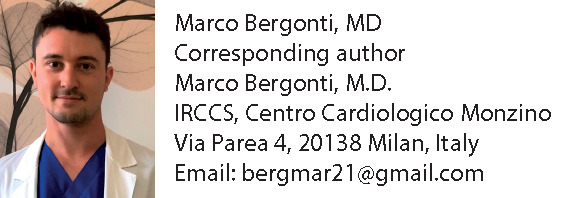I think everybody working in the emergency department (ED) has experienced some frustration when, after 10 h of hard work, you have been asked to evaluate the umpteenth asymptomatic, healthy young adult, presenting with high values of blood pressure. You diligently collect the personal history, patiently ask about symptoms, and then perform a thorough physical examination. Putting together all the data collected, you conclude that this patient has nothing but uncontrolled essential hypertension. The pressure drops just by resting in the bed and you discharge them thinking that hospital resources could have had a better use.
That was ordinary life. That was before COVID-19.
However, when at the end of February, the COVID-19 crisis exploded in Italy, those working in the ED experienced something very unusual. Something became particularly evident in our tertiary referral centre for cardiovascular diseases in Milan, where people and ambulances usually come for presumptive cardiovascular disease. Two main phases can be identified.
The first half of March
Television and the Internet advised against leaving home. Hospitals were identified as the most dangerous places to be in. At first, we all thought: at least now people with mild or no cardiovascular issues will stop crowding our ED and we will finally be able to fully dedicate ourselves to those who really need it. In addition, while most hospitals were overwhelmed by COVID-19 patients with pneumonia, we were asked by the government to stay COVID free to care appropriately for cardiovascular patients. Thus, our hospital rapidly became the centre of reference in a territory populated by ∼1 200 000 people (six times more than usual).
However, the number of people coming to the ED decreased by 30%.
The sad reality slowly became evident. Not only people with mild issues stopped coming to the ED; even those who really needed help preferred to stay home. Indeed, the number of ST segment elevation myocardial infarction (STEMI) dropped by 30%.1 For the first 2 weeks of the crisis, while other hospitals were exploding, overwhelmed by COVID patients with pneumonia, we were astonishingly unoccupied waiting for myocardial infarctions that did not arrive.
The second half of March
Few patients eventually started asking for help in the ED. But then, it was often too late. Indeed, what marked the second half of the month was the increase in the mortality rate for conventional cardiovascular disease.2 Indeed, the stable death rate for the myocardial infarction of 4–6% during the past years increased during the second half of March to 18%, as a consequence of the delay in reaching for appropriate care.
Only few among the senior doctors were able to remember a scenario like this, back at the time when myocardial infarction was treated with morphine and bed rest. Mechanical and electrical complications of MI became routine. Many young, otherwise healthy patients required inotropes, intra-aortic balloon pump, even Extracorporeal Membrane Oxygenation, and urgent heart transplantation.
I will always remember the stories of these patients whose life dramatically changed because they were too afraid to call for help when experiencing chest pain. Many middle-aged healthy men, in their fifties, presented to the ED 1 week after the onset of symptom, with an anterior STEMI frozen in its second stage and with an ejection fraction of 15%. Not because they were unaware of symptoms, but because the fear of COVID was greater. Indeed, when talking to their family, one phrase was being constantly repeated: ‘he did not feel well for a few days, but he didn’t want to go to the ED’.
So now, whenever I examine the 33-year-old healthy patient who inappropriately came into the ED, I start to appreciate a bigger picture. Because, if it is true that the great majority of these patients have no urgent medical issue; what I have learnt from this story is that only by giving people adequate faith and trust that they can come to the ED whenever they want to and for whichever symptoms they feel, will we be able to timely find and adequately treat the 50-year-old man with an anterior STEMI.
Now that the second wave is overwhelmingly spreading, we find ourselves back to the beginning of March. However, in our armamentarium, we now have awareness. And, among other things, we should really try to make the ED a safe and secure place for everybody who needs it. Only in this way, will we be able to prevent avoidable deaths resulting from a delayed presentation of common cardiovascular diseases.
Conflict of interest: none declared.

References
- 1. De Filippo O, D’Ascenzo F, Angelini F, Bocchino PP, Conrotto F, Saglietto A, Secco GG, Campo G, Gallone G, Verardi R, Gaido L, Iannaccone M, Galvani M, Ugo F, Barbero U, Infantino V, Olivotti L, Mennuni M, Gili S, Infusino F, Vercellino M, Zucchetti O, Casella G, Giammaria M, Boccuzzi G, Tolomeo P, Doronzo B, Senatore G, Grosso Marra W, Rognoni A, Trabattoni D, Franchin L, Borin A, Bruno F, Galluzzo A, Gambino A, Nicolino A, Truffa Giachet A, Sardella G, Fedele F, Monticone S, Montefusco A, Omede P, Pennone M, Patti G, Mancone M, De Ferrari GM. Reduced rate of hospital admissions for ACS during Covid-19 outbreak in Northern Italy. N Engl J Med United States 2020. [DOI] [PMC free article] [PubMed] [Google Scholar]
- 2. Baldi E, Sechi GM, Mare C, Canevari F, Brancaglione A, Primi R, Klersy C, Palo A, Contri E, Ronchi V, Beretta G, Reali F, Parogni P, Facchin F, Bua D, Rizzi U, Bussi D, Ruggeri S, Oltrona Visconti L, Savastano S. Out-of-hospital cardiac arrest during the Covid-19 outbreak in Italy. N Engl J Med United States 2020. [DOI] [PMC free article] [PubMed] [Google Scholar]


